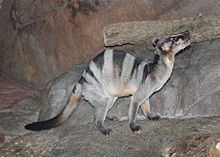| Banded palm civet | |
|---|---|

| |
| A banded palm civet in the Cincinnati Zoo | |
| Scientific classification | |
| Domain: | Eukaryota |
| Kingdom: | Animalia |
| Phylum: | Chordata |
| Class: | Mammalia |
| Order: | Carnivora |
| Suborder: | Feliformia |
| Family: | Viverridae |
| Genus: | Hemigalus Jourdan, 1837 |
| Species: | H. derbyanus[1]
|
| Binomial name | |
| Hemigalus derbyanus[1] (Gray, 1837)
| |
| Subspecies[3] | |
| |

| |
| Banded palm civet range | |
| Synonyms | |
|
Paradoxurus derbyanus[1] | |
The banded palm civet (Hemigalus derbyanus[a]), also called the banded civet, is a viverrid native to Indomalaya. They primarily inhabit lowland conifer habitat, which is under threat from encroaching human activity. It is estimated the population of the banded palm civet has decreased by around 30% in just three generations. Banded palm civets are usually approximately the size of a domestic cat; their fur is pale but with dark bands on the back. They are believed to be closely related to Hose's palm civets, which are similar in appearance and distribution.
The banded palm civet is the only species in its genus, first scientifically described in 1837. The species comprises four subspecies, distributed across Indonesia and Southeast Asia. Two of the subspecies diverged from each other as long ago as 2.7 million years.
Banded palm civets are affected by a variety of parasites, such as nematodes, and are primarily carnivorous, eating small animals such as rodents and bugs. They have sensitive hairs on their paws which help them to detect potential prey.
- ^ a b Wozencraft, W. C. (2005). "Species Hemigalus derbyanus". In Wilson, D. E.; Reeder, D. M. (eds.). Mammal Species of the World: A Taxonomic and Geographic Reference (3rd ed.). Johns Hopkins University Press. pp. 532–628. ISBN 978-0-8018-8221-0. OCLC 62265494.
- ^ a b Ross, J.; Brodie, J.; Cheyne, S.; Chutipong, W.; Hedges, L.; Hearn, A.; Linkie, M.; Loken, B.; Mathai, J.; McCarthy, J.; Ngoprasert, D.; Tantipisanuh, N.; Wilting, A.; Haidir, I.A. (2015). "Hemigalus derbyanus". IUCN Red List of Threatened Species. 2015: e.T41689A45216918. doi:10.2305/IUCN.UK.2015-4.RLTS.T41689A45216918.en. Retrieved 24 January 2022.
- ^ Cite error: The named reference
Veronwas invoked but never defined (see the help page). - ^ "Wildlife of RER: Banded Palm Civet". 2021. Retrieved 2023-08-16.
Cite error: There are <ref group=lower-alpha> tags or {{efn}} templates on this page, but the references will not show without a {{reflist|group=lower-alpha}} template or {{notelist}} template (see the help page).
